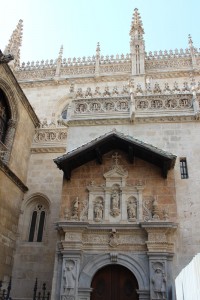
Following on from my post about Granada’s Carthusian Monastery, my second mission on my visit to Granada last Friday was to visit La Capilla Real, the Royal Chapel, where Ferdinand II of Aragon, Isabella I of Castile, Joanna of Castile and Philip I (Philip the Handsome) are buried.
It was a wonderful day to visit Granada because it was also the Fiesta de las Cruces (Festival of the Crosses) so the city was full of plazas decorated with floral crosses and everyone was dressed in flamenco garb – beautiful! Even women dressed in business suits for work had a flower pinned in their hair and children in pushchairs were wearing flamenco suits or dresses! Every now and then the traffic would stop for groups of men in Flamenco suits and hats on horseback – I do love Spain!
Anyway, back to the Capilla Real, the Royal Chapel which is famed for being the resting place of Los Reyes Católicos (the Catholic Monarchs), Ferdinand and Isabella, or Fernando and Isabel as the Spaniards refer to them. Those of you who have visited the Alhambra, the Moorish palace, in Granada will know that Ferdinand and Isabella were responsible for taking Granada from the Moors in 1492. The 16th century monarchs, therefore, have a very special place in the hearts of the people of Andalucia, Spain, and there are many public place and buildings named after them. Those of you who are interested in Catherine of Aragon, or Cataline de Aragón as she’s known in Spain, will be interested to know that Catherine of Aragon’s home was Granada (the Alhambra palace) before she set sail for England in 1501 to marry Arthur, Prince of Wales.
Photography was not allowed in the chapel itself, although it would have been impossible to photograph the effigies on the tombs anyway because they tombs stood much taller than me. You would have needed scaffolding or a ladder to take a proper photo so I bought postcards. What I found fascinating was that there were steps to go down into the floor beneath the effigies and there was a window cut into it so that you could see their actual coffins in the crypt. It was quite moving to see a posy of flowers, the 16th century wooden crucifix and the four ancient wooden coffins of Fernando, Isabel, Juan and Felipe El Hermoso (Philip the Handsome).
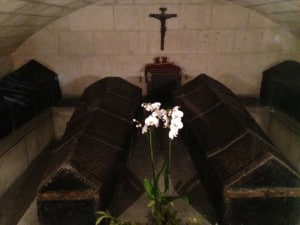
Here are some facts about the Capilla and Ferdinand and Isabella:
- Granada became part of the Kingdom of Castile under Ferdinand and Isabella.
- Isabella and Ferdinand are known for uniting all Spanish states under one monarchy and also linking Spain to Portugal, England and Austria through arranged marriages.
- The conquest of Granada and the defeat of the Moors led to the expeditions of Christopher Columbus which, in turn, opened up the New World. This is why 1492 is seen as the start of the beginning of the Modern Era in history.
- Granada became the centre, or capital, of the reign of the Catholic monarchs.
- The Capilla Real was founded as the mausoleum of Ferdinand and Isabella by Royal Warrant on 13 September 1504. Construction began in 1506 and the chapel was completed in 1517.
- The tomb of Ferdinand and Isabella was sculpted in 1517 by Italian Domenico Fancelli. Bartolomé Ordóñez was responsible for the tombs of Juana and Felipe which dates to 1520.
- The sacristy museum houses the Royal Warrant commissioning the building of the chapel, tapestries, Isabella’s crown and sceptre, Ferdinand’s sword, liturgical items and personal items belonging to Isabella (Gothic altar cross, chalice, peace-offering, chalice, girdle, rosary and mirror. The Queen’s Missal, a work on vellum by Francisco Flores (1496), is also on display, as is a statue of St Catherine.
- The Capilla is home to a collection of paintings which once belonged to Isabella – Artists include Botticelli, Perugino, Berrugueti and Bermejo.
- The Passion Altarpiece was made by Jacob Florentino in 1521 and on each side of it are carvings by Felipe Vigarny of Ferdinand and Isabella kneeling in prayer.
- The outside of the Capilla features crestings with the repeated letters of “F” and “Y” for Ferdinand and Isabella/Ysabel.
- The Capilla is still a place of worship where the Eucharist is celebrated on a daily basis.
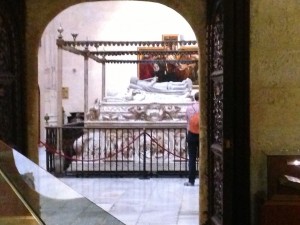
The following prayer features in the leaflet I was given as I entered the Capilla:
“We give you thanks, Lord,
for all that Queen Isabel
did for the Catholic faith,
for her family life,
and governing actions,
that were always
inspired and sustained by an
intense spiritual life.
We wish that she serve
an inspiration, and we wish
that her example of wife and
mother,
of woman
and Christian governess,
serve as guide.
We supplicate, Lord,
that if You issue it
and that it serve
for the good of man,
that her virtues be recognized
by the Church
and that we venerate her publicly
and ask for her intercession
before you. Amen.”
I’m just about to watch the first season of “Isabel”, the Spanish TV series about Isabella of Castile, which I bought on DVD as I missed too much of it on TV. It’s supposed to be excellent and is up for some awards so I’m looking forward to getting ‘stuck in’. It’s only available in Spanish with Spanish subtitles at the moment, but if you speak Spanish then it will definitely be worth you getting hold of.
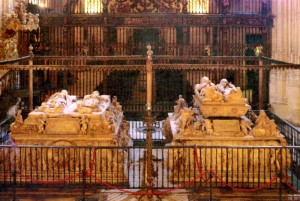
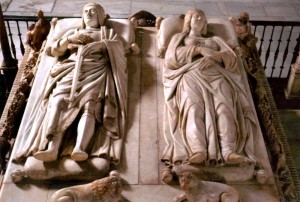
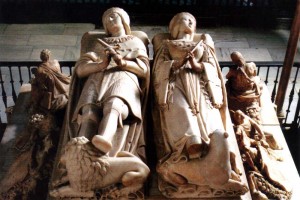

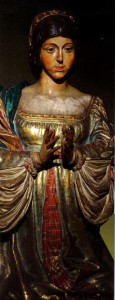
For those of you interested in the Fiesta of the May Crosses:

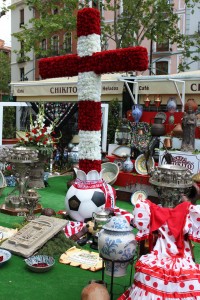
The Capilla Real (along with the rest of Granada) is gorgeous, and of course a great place for a history enthusiast to geek out a little. I remember visiting there and while telling my husband who the various people were and how they were all related, I ended up with a small English-speaking crowd around me asking their own questions (“What does the Y stand for?” is the only one I remember). Tour Guide For A Day, that was me.
What stunning Tombs they rest in,I would love to see in my life time,the mother and farther of ‘Queen Katherine,these souls lived and where great rulers that shaped our world!!So Historic! that we still know were they are,unlike alot of the others,back in the days of the great, Kings and Queens of the world,Amazing!! Baroness x
Lady Claire,
Thank you SO much for this post. And the photographs are otherworldly. They truly are magnificent. The effigies are so moving as is the (prayer) pamphlet that you were given. I really cannot get over the architecture within the top photograph. So amazing… 😉
just to say a thank you to the very gifted photographer (tim) for these great photos,and of course the write up on this also gets my vote.
Thanks, Margaret. Tim had a new camera for his birthday in the autumn and loves any excuse to use it. We’ll have to go back to the Alhambra as that is very photogenic.
Just to say what a lovely pictures and information.My mother is Spanish (catalan!) but her father and his family all came from granada.Her garandafather took her their but sadly she did not see the tombs of Isabel catlolica and ferdinad of Aragon.Perhaps its time we go a beautiful place Granada.I can’t wait to show mum these pictures.
Thank you very, very much for your report and pictures. All amaizing!
Angela
Brings back memories of my visit and those wonderful gardens, fountains, peaceful courtyards, the Islamic architecture, the lovely decorations, and of course the royal tombs. Yes, remember it well. Lovely Granada, and lovely palaces and the beautiful cathedral. We were there for two very busy days, but it is something that you do not forget. Lovely to see it again, if only on your photographs. Cheers.
Hi Claire, I visited Spain several years ago and loved my time in Granada. My mother-in-law Patte always told me to look at the effigies of Isabel and Ferdinand to see that even though they are carved in stone, Isabel’s head rests deeper in the stone than her husbands. The reason for this is that she bore the more important or weightier crown. I looked and yes its true.
The Spaniards so loved Isabellla and they say she was smarter than her spouse, so her head rested lower on the pillow. Remember she was a general, battle proven. I remember seeing her armor to accommodate her pregnancies. Her daughter Catalina, Catherine, was raised by a strong mother in battle camps. Strong mother, strong daughter!
Claire, once again a wonderful article and photos! Tim is getting to be a true professional; I have a cousin vey much into photography who has been taking photos for most of his life. The family is pushing for him to publish a book of the wild life he has captured; he has caught wild life in action shots that are just amazing. I think Tim’s photos are of the same quality. They invoke a feeling when you look at them and a desire to be there in person. A photographer can’t do better than that. Just one thing – by chance were there postcards of the opening that you saw through to the coffins? That would be so interesting to see.
Thank you, Sho! Tim had a posh camera for his birthday last year and has been reading lots of books and magazines on photography, he’s hooked! He’ll be thrilled to hear that you like his photos. The opening was a simple window and you got to it by going down some stairs behind the tombs. I can’t remember if there was a postcard of it. It was amazing that you could get to view what lay under the effigies.
Thanks for this Claire. I find Granada a wonderfully beautiful and inspiring place and I loved seeing the tombs. Interesting that even in the 21st century the prayer for Isabella celebrates her piety and her maternal and wifely excellence much more than her strong reign as queen.
Thank you for sharing this. I had a memory today of visiting the sarcophagi of Ferdinand and Isabella in Granada in 2005, and remembered how the coffins were actually in a little crypt in the basement. It was so strange. Thank you for helping me relive the memories!
Both seasons of Isabel is on Drama Fever and it has English subtitles. I’m on the 2nd season now. It’s fantastic.
Claire, Thank you for sharing all those beautiful shots and information from Granada. Until I read “The Constant Princess” by Phillippa Gregory I had forgotten what a warrior Queen Isabella was and that she did run the Moors out of Spain and unite the country. I ususally just associated her with selling her jewels to finance Columbus’s voyages to the New World. I love all history, but am such an Anglophile!
Great shots! And the postcards reminded me of the tomb Henry VIII commissioned for his parents in Westminster Abbey (created by Pietro Torrigiano & the first piece of Renaissance artwork in England). However, these tombs cross the divide between medieval & Renaissance design. For all the magnificent carving of the tombs, the coffins are, for me, the more moving, especially with the flowers. They show that someone still cares.
For most of my life I have wanted to visit the tomb of queen isabella. When I did, my feelings were emotional and overwhelming for me. To be in the presence of the remains of the tombs, gave me a warm feeling and spiritually I felt the love that this family had for each other even in death. I will always remember this and feel privilaged because of it. Thankyou to the staff and all those that honour queen isabella . I truly believe that she dedicated herself, for the better of her people, country and most of all her god. THANKYOU QUEEN ISABELLA.
Claire, thank you so much for sharing your photos of your trip to Spain, especially,
Granada. They were truly the first modern rulers. They looked to the new world and not the old.